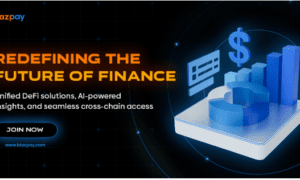Maham Saeed
The healthcare industry is rapidly evolving, with advancements in technology shaping the way patient care is delivered. Among the most impactful innovations is AI-driven predictive analytics. By leveraging artificial intelligence (AI) to analyze large datasets, healthcare providers can predict patient outcomes, enhance decision-making, and streamline operations. Predictive analytics in healthcare is not just a futuristic concept; it is a present-day solution that is changing the landscape of healthcare business strategies. This transformation offers the potential for more efficient care, reduced operational costs, and most importantly, an improved patient experience.
As businesses and healthcare organizations continue to adopt AI-driven predictive analytics, they are discovering new ways to enhance their strategies and drive meaningful change. This powerful tool not only aids in predicting patient outcomes but also helps optimize hospital operations, reduce wait times, and even foresee potential health risks before they manifest. With AI’s ability to process vast amounts of data quickly and accurately, healthcare providers can make data-driven decisions that lead to better patient care and more efficient business practices. The focus is shifting towards a more patient-centric approach, where care is tailored to individual needs, ensuring that healthcare delivery becomes not only more effective but also more compassionate.
The Rise of AI in Healthcare Analytics
The integration of AI into healthcare analytics is revolutionizing how medical professionals approach patient care. Predictive analytics allows providers to anticipate patient needs, enabling them to take proactive measures that prevent adverse health events before they occur. By analyzing historical medical records, demographic data, and real-time information, AI algorithms can predict the likelihood of a patient developing a particular condition. This foresight empowers clinicians to intervene earlier, which not only improves patient outcomes but also reduces healthcare costs associated with late-stage treatments.
Healthcare systems are leveraging AI to create smarter business strategies that focus on efficiency. For example, AI can optimize staffing schedules based on predicted patient volumes, reduce hospital readmission rates, and even forecast the need for medical supplies. By harnessing these insights, organizations can allocate resources more effectively, reduce waste, and ultimately increase profitability. AI’s potential to enhance operational efficiency, while simultaneously improving patient care, makes it an essential tool for healthcare providers looking to stay competitive in a rapidly changing industry.
Enhancing Patient-Centric Care with Predictive Analytics
One of the most significant advantages of AI-driven predictive analytics is its ability to place the patient at the center of care strategies. Traditional healthcare models often focus on treating illness once symptoms appear, but predictive analytics flips this approach by enabling preventive care. By analyzing a patient’s health data over time, AI can predict potential health issues and suggest personalized preventive measures. This allows healthcare providers to create tailored treatment plans that address individual risks and needs.
For example, AI can predict a patient’s risk for chronic diseases such as diabetes, cardiovascular disease, or cancer, based on their medical history, lifestyle choices, and genetic factors. This allows healthcare providers to intervene early, recommending lifestyle changes or medications that can prevent the onset of these conditions. By empowering patients to take charge of their health before problems arise, predictive analytics fosters a more proactive and personalized approach to care that enhances patient satisfaction and engagement.
Reducing Operational Costs Through AI Analytics
The financial aspect of healthcare has always been a significant challenge, with rising costs and inefficiencies plaguing healthcare systems globally. AI-driven predictive analytics helps reduce operational costs by streamlining processes and improving resource allocation. Hospitals and healthcare facilities can predict patient admissions, optimize bed management, and reduce unnecessary tests or treatments. This level of precision allows healthcare organizations to allocate resources more effectively, reducing waste and lowering the cost of care.
Additionally, AI algorithms can help identify cost-saving opportunities by pinpointing inefficiencies in the healthcare supply chain. By predicting demand for medical supplies and equipment, hospitals can better manage their inventory, avoiding overstocking or understocking. This leads to significant cost savings and a more sustainable healthcare operation. By reducing waste and enhancing efficiency, predictive analytics plays a pivotal role in ensuring the long-term financial viability of healthcare organizations.
Real-Time Data and Decision Making in Healthcare
In today’s fast-paced healthcare environment, decision-making must be based on real-time data to ensure the best possible patient outcomes. AI-driven predictive analytics makes this possible by processing vast amounts of real-time data and offering actionable insights to clinicians and administrators. Whether it’s predicting a patient’s response to a treatment or identifying the potential for medical complications, AI can process and analyze data in ways that the human mind alone cannot.
By providing healthcare professionals with immediate insights, AI enhances clinical decision-making, reducing the chances of errors and improving overall patient care. Real-time data also enables healthcare organizations to make immediate adjustments to their operations, whether it’s altering staffing levels, managing patient flow, or reallocating resources. This ability to adapt swiftly ensures that healthcare providers can meet the evolving needs of patients and improve their service delivery, all while maintaining high levels of efficiency.
Leveraging AI to Improve Patient Outcomes
Improving patient outcomes is at the heart of AI-driven predictive analytics. By identifying health risks early and suggesting interventions, AI enables healthcare providers to offer more accurate and timely care. Predictive models can assess a patient’s risk of complications based on their current condition, medical history, and other factors, allowing doctors to make better-informed decisions.
Moreover, AI allows for continuous monitoring of patients, especially in critical care settings. With the help of wearables and connected devices, healthcare providers can monitor vital signs in real time and receive alerts when a patient’s condition is deteriorating. This proactive approach enables healthcare providers to intervene quickly, preventing adverse events and improving patient safety. Ultimately, AI helps healthcare providers achieve better outcomes by ensuring that patients receive the right care at the right time, minimizing the chances of errors or delays in treatment.
The Role of AI in Streamlining Healthcare Operations
Healthcare operations are often complex, involving numerous departments, staff members, and systems that need to work together seamlessly. AI-driven predictive analytics helps streamline these operations by providing insights that guide decision-making at every level of the organization. By predicting patient demand, AI can help optimize staffing, reduce patient wait times, and improve overall patient flow. These efficiencies not only enhance the patient experience but also increase the overall productivity of healthcare staff.
Furthermore, AI can assist in automating routine administrative tasks, such as scheduling, billing, and claims processing. By automating these processes, healthcare organizations can reduce the burden on staff and free them up to focus on patient care. This shift towards automation not only enhances efficiency but also reduces the chances of human error, ensuring a smoother and more reliable healthcare operation.
Future Trends in AI-Driven Predictive Healthcare Analytics
As AI continues to evolve, so too will its applications in healthcare. The future of AI-driven predictive analytics holds exciting potential for even greater efficiency and improved patient care. For example, as AI algorithms become more advanced, they will be able to predict even more complex health issues, offering more precise recommendations for personalized treatment plans.
Additionally, the integration of AI with other emerging technologies, such as the Internet of Things (IoT) and blockchain, will further enhance predictive analytics. IoT devices will provide real-time data on patients’ health, while blockchain technology will ensure secure data sharing between healthcare providers, making the entire healthcare system more interconnected and efficient.
The role of AI in healthcare will continue to expand as new technologies emerge and healthcare organizations embrace these advancements. The possibilities are limitless, from enhancing operational efficiencies to improving patient outcomes, all driven by AI-powered predictive analytics.
Unlocking New Business Strategies Through AI-Powered Insights
AI-driven predictive analytics is not only transforming the way healthcare providers interact with patients but is also reshaping healthcare business strategies. As healthcare providers gather more data, they gain valuable insights into patient behaviors, preferences, and treatment outcomes. These insights allow organizations to develop targeted business strategies that align with patient needs, improve customer satisfaction, and reduce costs.
For example, AI can be used to develop tailored marketing strategies based on patient data. By understanding patient preferences, healthcare organizations can deliver personalized marketing messages and services, creating a more loyal patient base. Additionally, AI can help healthcare organizations identify profitable market segments and expand their reach into underserved areas, driving business growth and sustainability.
In an increasingly competitive healthcare landscape, organizations that embrace AI-driven predictive analytics will have a significant advantage. By leveraging data to improve decision-making, enhance patient care, and streamline operations, healthcare providers can unlock new business opportunities and create strategies that are both efficient and patient-centric.
Written By: Maham Saeed





























